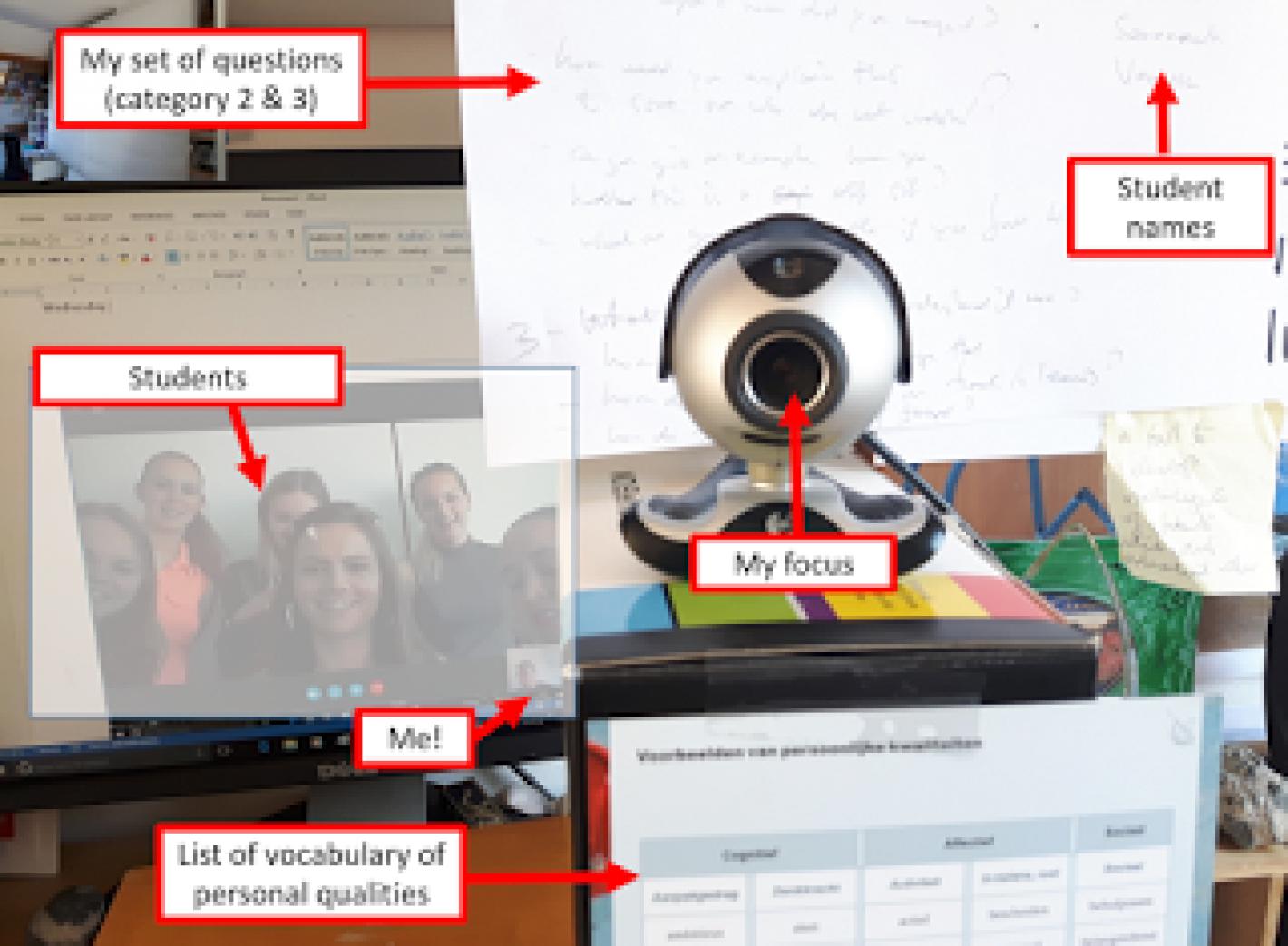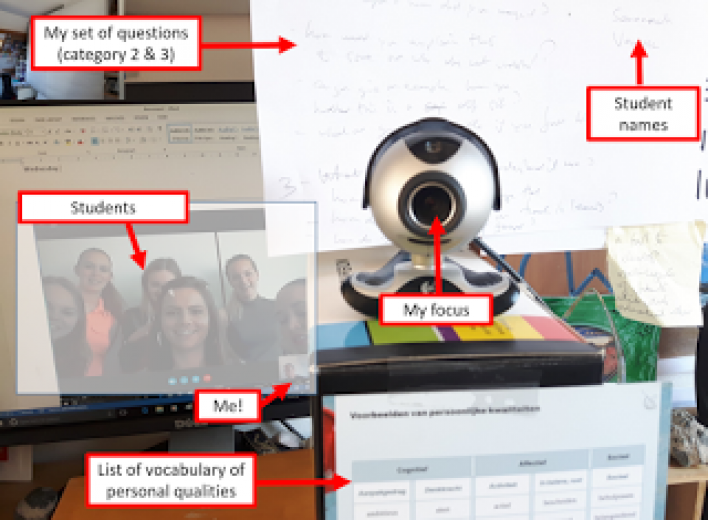In the last couple of weeks I’ve experimented in being a ‘remote’ project coach with a couple of groups. Below are my thoughts on a recent session. Due to scheduling situation, I could not meet my project group in person. We had planned in advance that we would do the meeting via video conference. I was at my home office and the six students were together in one meeting room at the school location. It was a third year class and it was the fifth week of a seven week project. The students had visited an international destination a few weeks ago, and had collected data in interviews, as part of their research process. Before the meeting, I took time to get a few things set up.
Setting up – room layout and technical issues
Getting prepared for the video call, I set up my office with the following things in mind:
Neutral backdrop – In order to avoid a distracting background behind my video image, I improvised some white sheets behind my desk (see photo)
Simple clothing – It was a hot day so I wore a plain black t-shirt which was designed to be informal, neutral and non-distracting.
My video camera position – At a good height (eye level when I’m sitting down) and close by to me, in order to maximise audio/microphone quality, and to keep the focus zoomed in on a head shot (I think this gives better communication)
Connecting via Lync - I had sent out an invitation to the group, and wanted to ‘record’ the session in order to reflect on it in more detail.
Setting up – Preparing feedback
I’m currently following a course on didactic coaching with Lia Voerman in which we specifically focus on giving feedback and I wanted to use this video session to practice this format and try some of the theory (Voerman, 2012). As preparation I prepared a set of specific questions based on the guidelines provided:
- Category 2 questions focus on the student’s learning strategy and their state of mind (e.g., Why do you think that did not work? Have you encountered a similar situation before and how did you deal with it? Can you give an example of how you handled this in a different situation? What are you going to do it you fall behind?
- Category 3 questions focus on cognitive self-regulation and reflecting on their current state of mind (modus). (e.g. Why is it that you can manage this situation better now? How are you going to arrange that? How do you ensure that you stay on task? How do you get yourself focused?).
I placed this set of questions just above my camera (see photo), so I could look directly into the camera, and also refer to the questions just by lifting my eyes slightly over the camera without losing too much eye contact. In didactic coaching, the idea is that once you ask one of the category questions, you have the chance to give feedback that should be; concise, specific and with a 3:1 ratio of positive to critical. In order to help give specific feedback, the course has provided us with a suggested list of vocabulary with examples of ‘personal qualities’. These are divided into three sections:
- Cognitive (e.g. ambitious, flexible, careful)
- Affective (e.g. active, open, positive) and
- Social (e.g. helpful, reliable, grateful)
I pasted this list of vocabulary just below my camera so I could pull out more specific feedback to support and focus my comments to the students, once they had given me their answers. The photo illustrates the various aspects of the communication process, and the preparation involved.
Ready to connect!
I tried to set up the meeting via Lync (Skype for business) since this is a more professional, and often more stable, format. However, there were problems connecting between the student laptop and my teacher account, so we reverted to Skype at the last moment. This is more informal and the audio quality is often variable, and it depends on good Wi Fi connections at both ends. The connection was not great, I could not record the meeting, but we could at least video conference.
In addition, I had not spent any time considering the layout of the room the students were in. They were in a small meeting room with a table. They were connecting via a laptop camera. In order for all of them to be on screen, three were sitting at the table, looking at the laptop. The other three were standing behind them. This meant I could see all of the students, but it turned out not to be so comfortable for them (it was a very warm day). After about 10 minutes of connecting issues (Skype accounts, emails and a phone call) we finally could see and hear each other.
What happened?
During the meeting I was trying to focus on asking the right questions and giving feedback based on the guidelines. To start with, there were quite a few specific and complex project issues to discuss. Once we had addressed those, I started to weave some of the questions on the list into the discussion, trying to do this in a natural and unobtrusive manner. I did this by asking one specific student by name. When there was more than one student talking at the time, I tried to go back to the person I asked and then to the second person who joined in. Once they answered the question, I tried to give them immediate feedback using the format and vocabulary. An example is something like:
‘Thank you ‘X’ for that observation. You used very precise language to give a clear and structured explanation. That helps me to understand it’
Or
‘Thank you ‘Y’. That answer shows your focus and also your ambition. It is inspiring!’
Thanking them, using their name and giving this specific feedback using a variety of rich vocabulary, certainly engaged the students. It also created an engaged and positive atmosphere in the group with lots of laughter.
At one point we had an unexpected visitor during the interaction. My ten year old daughter was unwell and at home for the day. But there was an emergency; the iPad was almost out of juice and she needed to come into my office to collect the charger! She appeared in the background of my video and the students saw her. I took this as an opportunity to introduce my daughter to the students and vice versa. Thinking back now, I had recently watched the video of an expert being interviewed live on BBC when he is interrupted by his family; first his 3 year old child walks into his office, then his toddler, followed by his wife rushing in, trying to get them out of the picture.
I decided to try to take a slightly more measured approach. I introduced my daughter to the students and explained the nature of the emergency (by holding up the white iPad charger which enabled all the students to understand the situation immediately). I then tried to return to our discussion in a business-like manner. However, my carefully controlled and planned ‘office environment’ had been revealed for what it was. This raises questions about professionalism and how much of your private life one shares with students. In this case, it was an informal environment and I think everyone understood the situation. It also showed me (for the first time) in a different light, as a father. I made a screen shot of the Skype moment to capture this informal temporary moment of interaction and laughter.
What did the students think of this session?
At the end of the 30 minutes, I explained to the students that I was experimenting with different teaching and video formats and asked for specific feedback from them. This is a very loose overview of their comments:
‘I think it’s a good idea by Skype. But instead of 30 minutes you need 45 minutes. We lost time getting the meeting set up due to technical reasons.’
‘A general remark. Actually, I think that in the first two years of our study, 30 minutes is o.k. But in year 3, we need more time because we have more questions.’
‘The sound is not always good. Connection is not good. The sound quality was poor.’
‘It does help that you are very interactive. With a meeting like this, it is good to have the web cam on, it really adds something.’
‘The other annoying thing. We have to stand at the back. And we can’t write anything down. I don’t like it. For the rest, its o.k.’
‘To do it by phone would be better. It is a better link. I don’t mind if we can see each other. And we can make notes.’
‘I really like this kind of meeting with Skype. I think it is a good think we can see you. It feels more connected. Everyone can be more flexible when we can’t meet at the same location. We have more options to meet.’
Suggested improvements for next time
- Reserve one of our ‘360 meeting rooms’ for the students. The camera is in the middle, audio/image is good via a stable Lync connection, students can sit, comfortably and make notes.
- Have the list of questions better worked out in advance (more questions, typed out clearly, and better thought out; which questions could I ask to which students at which point?).
- Try to keep track of which questions I’ve already asked (perhaps have them on a deck of flash cards)
- Add my own specific examples of vocabulary for personal qualities so I can jump more quickly to find specific vocabulary.
- If the Lync connection is working, record the meeting (with permission of the students) in order to analyse the questions I used, how many of which sort I asked, how well I listened to the students, and gave them adequate space to think and answer.
Reflection
I found the students to be prepared, engaged and fully focused. The session was positive, we covered a lot of detailed information, we shared ideas and we laughed (which is always good). I was able to practice giving honest and detailed feedback and collect ideas for improvements on my teaching.
It was sometimes complicated dealing with the various points of focus; where I had to look, what I had to think, say and do. From a TPACK (Mishra & Koehler, 2006) perspective these points required simultaneous focus:
- Technical: connection, sound, image
- Pedagogical: listening, engaging, giving the feedback
- Content: Stay on track with specific details, reaching the goals of the discussion
I will certainly continue to experiment with this format and share future ideas on this. Perhaps you have some tips from your own experience so please share on the blog below.
Shortly after I’d finished the meeting, I received a mind map from the group, showing that they had taken the discussion to the next level, and wanted to share it with me. I see this as a sign of positive engagement and a good note on which to conclude this blog!
Sources
Mishra, P., & Koehler, M. J. (2006). Technological pedagogical content knowledge: A framework for teacher knowledge. Teachers College Record, 108(6), 1017–1054. http://doi.org/10.1111/j.1467-9620.2006.00684.x
Turkle, S. (1984). The second self; Computers and the human spirrt (20th Anniv). Cambridge, MA: MIT Press.
Turkle, S. (2012). Alone together: Why we expect more from technology and less from each other. New York: Basic Books.
Turkle, S. (2016). Reclaiming conversation; The power of talk in a digital age. New York: Penguin Books.
Voerman, L. (2012). Teacher feedback in the classroom; Analyzing and developing teachers’ feedback behavior in secondary education. University of Utrecht. Retrieved from http://www.didactischcoachen.nl/images/pdf/Proefschrift_Lia_definitief.pdf
Posted 17th May by Zac Woolfitt



 Same time, different places?
Same time, different places?


